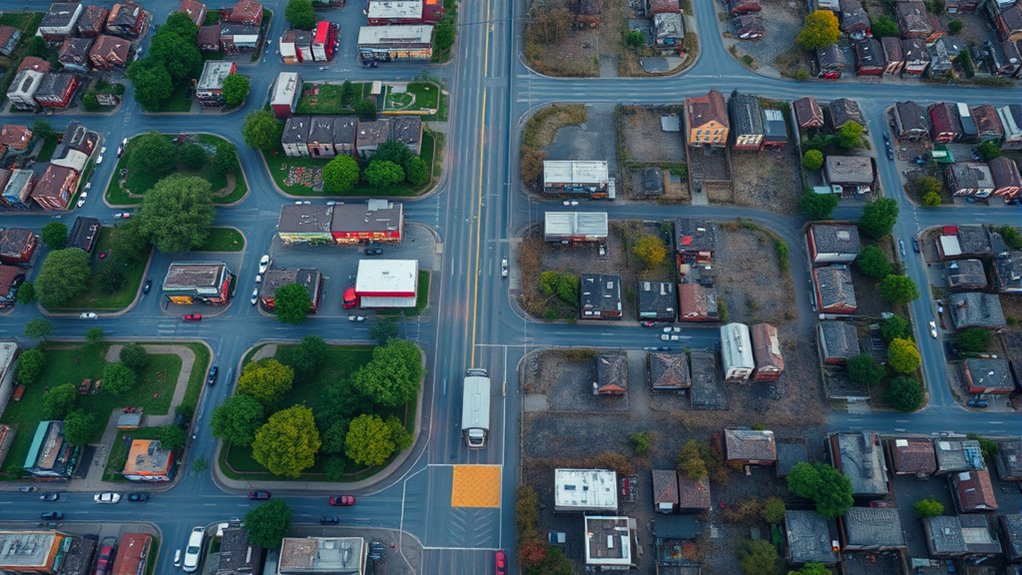Mapping access inequality in cities reveals where food deserts exist, highlighting areas with limited access to affordable, nutritious food. Using tools like satellite imagery and GPS tracking helps identify these neighborhoods and understand their geographic patterns. Factors such as poor urban planning, transportation barriers, and socioeconomic disparities contribute to food deserts. You’ll discover how innovative technologies and community efforts work together to address this issue and create healthier, more equitable urban environments.
Key Takeaways
- Geospatial technologies like satellite imagery and GPS tracking identify locations of food outlets and neighborhood barriers.
- Mapping tools reveal spatial patterns of food deserts correlated with socioeconomic disparities in urban areas.
- Combining satellite data and mobile mapping enables precise identification and prioritization of food access issues.
- Urban planning, zoning, and transportation infrastructure significantly influence the formation and persistence of food deserts.
- Data-driven maps support targeted interventions, such as urban agriculture and policy reforms, to improve food access equity.
Defining Food Deserts and Their Impact

What exactly are food deserts, and why do they matter? Food deserts are areas where residents have limited access to affordable, nutritious food, often due to a lack of grocery stores or markets. They directly contribute to nutrition disparities, making it harder for communities to maintain healthy diets. Urban planning plays a *vital* role in creating or mitigating these deserts by influencing where stores are located and accessible. When neighborhoods lack nearby supermarkets, residents may rely on convenience stores with unhealthy options, worsening health outcomes. Recognizing how urban planning impacts food access helps target interventions to reduce disparities. Addressing food deserts isn’t just about food; it’s about fostering equitable communities where everyone can make healthy choices.
Methods for Mapping Food Access

To understand how food access varies, you need to explore geospatial data collection methods that gather location-specific information. Using spatial analysis techniques helps identify areas with limited food options by examining patterns and distances. These tools enable precise mapping of food deserts, guiding targeted interventions. Incorporating well-being tips related to health and support can also enhance community resilience and promote healthier living environments.
Geospatial Data Collection
Have you ever wondered how researchers accurately identify areas lacking access to healthy food? They rely on geospatial data collection methods like satellite imagery and GPS tracking. Satellite imagery provides a broad view of urban landscapes, highlighting locations of food outlets and neighborhood features. This data helps map the distribution of grocery stores and convenience stores from space, revealing potential food deserts. Meanwhile, GPS tracking involves collecting real-time location data from individuals or vehicles, showing how people navigate their neighborhoods. By combining satellite images with GPS data, researchers can pinpoint exactly where food access is limited and understand travel patterns. These tools give a detailed picture of food environments, enabling targeted interventions and more precise identification of areas with inadequate food access. Additionally, projector compatibility with various data collection tools can enhance spatial analysis accuracy.
Spatial Analysis Techniques
Spatial analysis techniques are essential for accurately mapping food access and identifying food deserts. By applying methods like network analysis, you can trace actual travel paths to grocery stores, revealing barriers that often go unnoticed. Remote sensing also plays a crucial role, providing satellite imagery that highlights land use patterns and accessibility challenges. These tools enable you to visualize disparities and understand how urban layouts impact residents’ ability to access healthy food. Incorporating encryption solutions can help protect sensitive geographic data from unauthorized access or tampering, ensuring community insights remain secure.
Key Factors Contributing to Food Desert Formation

Several interconnected factors drive the formation of food deserts, making it difficult for residents to access affordable, nutritious food. Urban planning plays a significant role, as poorly designed neighborhoods may lack grocery stores nearby or favor commercial developments over essential services. Transportation infrastructure also impacts access; limited public transit options or poorly maintained roads hinder residents’ ability to reach stores outside their immediate area. When cities neglect to contemplate equitable distribution of healthy food sources, food deserts emerge, especially in low-income communities. Additionally, zoning policies and economic disinvestment can discourage grocery store development in certain neighborhoods. Understanding systemic issues helps explain how these barriers are perpetuated. Together, these factors create barriers that prevent residents from obtaining fresh produce and healthy options, perpetuating health disparities and food insecurity.
Analyzing Geographic Patterns of Food Deserts

You can observe how food deserts often cluster in specific areas, revealing clear spatial distribution patterns. These patterns tend to align with socioeconomic factors, showing that lower-income neighborhoods are more affected. Understanding these connections helps you identify where food access issues are most urgent. Additionally, geographic analysis of location-specific climate factors can inform targeted interventions for improving food availability.
Spatial Distribution Trends
Understanding the geographic distribution of food deserts reveals significant patterns that highlight disparities in access to healthy foods. You’ll notice that urban sprawl often extends low-income neighborhoods into areas with limited grocery stores, intensifying food insecurity. Zoning policies can either mitigate or worsen these gaps, depending on how they prioritize commercial food outlets. Additionally, analyzing market research can identify underserved areas and inform equitable zoning decisions. Key trends include:
- Food deserts frequently cluster in rapidly expanding suburbs affected by urban sprawl.
- Inconsistent zoning policies create barriers to establishing affordable grocery stores in underserved areas.
- Inner-city neighborhoods may experience fewer food access issues due to denser retail networks, but inequalities persist in less regulated zones. Recognizing these spatial patterns helps expose systemic barriers that perpetuate unequal food access across cities.
Socioeconomic Correlations
Examining the socioeconomic patterns of food deserts reveals a strong link between economic hardship and limited access to healthy foods. Areas with high income disparity tend to have fewer grocery stores offering nutritious options, forcing residents to travel farther. Low employment rates often correlate with increased food insecurity, as families lack the financial resources to buy fresh produce regularly. These neighborhoods typically face concentrated poverty, which discourages store development due to perceived low profitability. As a result, residents experience a cycle of limited access and poor health outcomes. Understanding these socioeconomic correlations helps identify communities most at risk, emphasizing the need for targeted policies that address income inequality and boost employment opportunities to improve food access. Recognizing the impact of economic hardship on food access underscores the importance of addressing broader social issues to mitigate disparities.
Case Studies: Food Deserts in Major Cities

Major cities across the globe face a growing challenge with food deserts—areas where residents have limited access to affordable, nutritious food. In cities like Detroit, Cape Town, and Mumbai, transportation barriers and limited urban agriculture hinder access, leaving many without fresh options. You see neighborhoods where grocery stores are scarce, forcing residents to travel long distances on unreliable transit. Such obstacles deepen inequality and health disparities. Enhancing urban agriculture and improving transit options could significantly increase access to healthy foods in these underserved areas.
- Families skipping healthy meals due to lack of nearby stores
- Children suffering from poor nutrition and related health issues
- Communities feeling forgotten and marginalized in urban planning efforts
These case studies reveal how urban agriculture initiatives and improved transportation could transform these areas, reconnecting residents with nourishing food and hope.
Technologies Used in Food Access Mapping

Advancements in technology have revolutionized how communities identify and address food deserts. Satellite imagery allows you to analyze large-scale land use patterns, pinpointing areas lacking grocery stores or fresh food sources. This high-altitude perspective provides detailed geographic data, helping you visualize food access barriers from afar. Meanwhile, mobile mapping enables you to gather real-time information by collecting GPS data as you walk or drive through neighborhoods. This technology helps you map walkability, store locations, and transportation routes efficiently. Combining satellite imagery with mobile mapping gives you a holistic understanding of food access issues. These tools empower you to identify food deserts more accurately, prioritize interventions, and support data-driven decisions that promote equitable food distribution across communities.
Policy Interventions and Community Initiatives

Policy interventions and community initiatives play an essential role in addressing food deserts by actively creating and supporting solutions that improve access to healthy food. Through urban agriculture projects, communities can transform vacant lots into vibrant food sources, fostering local resilience. Policy advocacy pushes for zoning laws that encourage grocery stores in underserved areas, making healthy food more accessible. These efforts empower residents to take control of their food environment and inspire change.
Policy and community efforts transform vacant lots into thriving food sources, increasing access and empowering residents.
Additionally, integrating air quality considerations can enhance the overall health benefits of these initiatives, ensuring that the environment in which food is grown and consumed is safe and clean. You witness neighborhoods come alive as urban farms flourish, offering fresh produce where it was once scarce. You see community members unite, advocating for policies that prioritize health and equity. You feel hope grow as local initiatives demonstrate that collective action can break down barriers to nutritious food, transforming lives for the better.
Challenges in Addressing Food Access Inequality

Addressing food access inequality faces numerous challenges that can hinder progress despite community efforts and policy initiatives. One major obstacle is transportation barriers, which make it difficult for residents in food deserts to reach healthy options. Limited public transit or lack of personal vehicles means many rely on distant stores or convenience outlets with poor nutritional choices. Urban agriculture offers a promising solution by increasing local food production, but it faces hurdles like zoning restrictions, lack of resources, and land access issues. These factors complicate efforts to grow fresh produce within communities. Combining transportation improvements with support for urban agriculture can help reduce disparities. Still, overcoming these structural barriers requires coordinated policies, community engagement, and sustained investment to guarantee equitable food access for all residents. Implementing hot rollers in community programs could also assist residents in maintaining healthy diets by encouraging better hair care routines that boost confidence and well-being.
Future Directions for Research and Action

To effectively bridge the gap in food access, future research and action must prioritize innovative, community-centered solutions that address underlying structural barriers. Embracing urban agriculture can empower neighborhoods, offering fresh food and fostering local resilience. Digital mapping technologies should be leveraged to identify food deserts precisely, enabling targeted interventions. By combining these tools, you can better understand spatial inequalities and develop sustainable strategies. Moving forward, your focus should be on collaborative efforts that involve residents, policymakers, and researchers. This approach ensures solutions are tailored and impactful.
- Discovering hidden food deserts through digital mapping inspires hope and action.
- Urban agriculture transforms vacant spaces into vibrant food hubs, restoring community pride.
- Inclusive research empowers marginalized voices, fueling equitable change.
Frequently Asked Questions
What Are the Health Effects of Living in a Food Desert?
Living in a food desert can substantially impact your health. Limited access to fresh, nutritious foods may lead to nutritional deficiencies, affecting your overall well-being. You might also experience mental health impacts due to stress and frustration over food insecurity. Over time, these challenges can increase your risk of chronic illnesses like diabetes and heart disease. Addressing these issues requires improved access to healthy foods, which can enhance both your physical and mental health.
How Do Food Deserts Affect Different Socioeconomic Groups?
You might notice that food deserts impact socioeconomic groups differently. Lower-income communities often struggle more due to income disparity, limiting their access to fresh, nutritious food. Cultural influences also shape food choices and availability, making some groups more vulnerable. As a result, these disparities lead to health inequalities, with marginalized groups facing higher risks of diet-related diseases, highlighting the urgent need for equitable food access solutions.
Can Urban Agriculture Help Reduce Food Deserts?
Urban agriculture, like community gardens and urban farms, can markedly reduce food deserts by increasing local food access. You can participate in or support these initiatives to grow fresh produce closer to underserved neighborhoods. These efforts empower residents, create jobs, and foster community ties. By promoting urban agriculture, you help bridge the gap in food access, making healthy options available where they’re needed most, ultimately improving overall well-being.
What Role Do Transportation Policies Play in Food Access?
Think of transportation policies as the veins that carry life through a city’s body. When public transit is robust, it opens pathways to nutritious food, connecting neighborhoods to grocery hubs. Zoning policies shape these routes, ensuring they serve all areas fairly. By investing in transit and inclusive zoning, you create a web of access, allowing everyone to reach healthy food options easily, reducing food deserts and fostering equity across the urban landscape.
How Do Food Deserts Vary Between Rural and Urban Areas?
You’ll notice that food deserts differ between rural and urban areas due to factors like rural isolation and urban density. In rural regions, low population density and limited transportation options make access to fresh food harder, creating larger food deserts. Conversely, urban areas often have higher density, but barriers like affordability and limited store availability can still cause food deserts, even with better transportation options.
Conclusion
You now understand how food deserts limit access to healthy food, affecting millions worldwide. Did you know that over 23 million Americans live in areas lacking grocery stores? By mapping these spaces, you can see where targeted efforts can make a difference. Addressing this inequality requires innovative policies and community action. Together, you can help create more equitable food environments, ensuring everyone has the opportunity to access nutritious food and improve public health.









